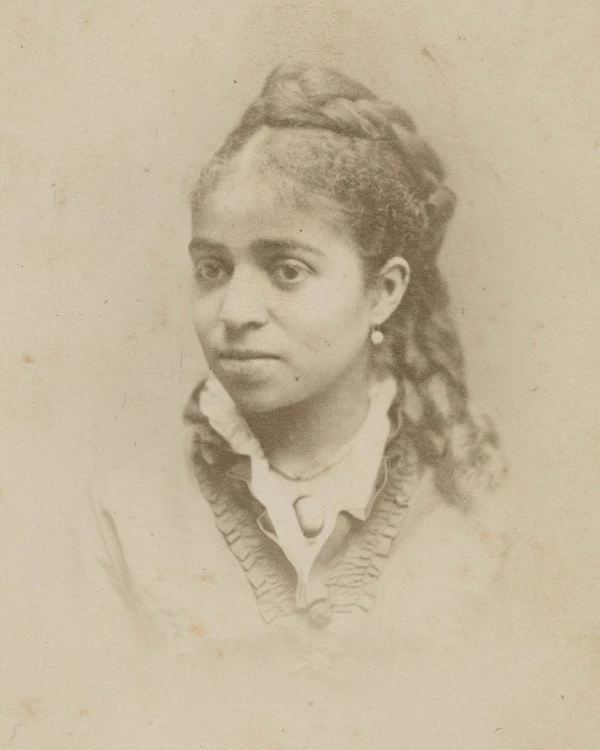Last updated: December 8, 2025
Person
Elizabeth Smalls Bampfield

Cabinet card taken by Allen & Rowell, June 1875, photo 247.714, Massachusetts Historical Society
In many families there is often somebody who is the keeper of the family history. Elizabeth Bampfield told her family’s story, and made sure the rest of the nation knew it too.
Elizabeth Smalls was born on February 12, 1858, in Charleston, South Carolina. Her parents were Hannah and Robert Smalls, just a few of the thousands of enslaved people who toiled in the city. Soon after Elizabeth was born, her father planned to purchase hers and her mother’s freedom. Hannah’s enslaver set the price of freedom at $800. To earn money, Robert took on extra work on the docks of Charleston, while Hannah worked as a seamstress. By 1860 they had nearly reached their financial goal. However, the opportunity to purchase their freedom seemed to slip away when the Civil War began in April 1861. It also almost certain that the Smalls family witnessed the bombardment of Fort Sumter in the Charleston Harbor. The sound of cannon booming across the city, paired with the flashing muzzles through the night must have been terrifying for the young toddler.
A little over of a year later, on the night of May 12, 1862, Elizabeth’s mother woke her up and took her, along with her step-sister and infant brother, to a nearby wharf. There, they boarded the Planter, with her father, Robert Smalls, in the captain’s chair. The Smalls family were not the only people on board that night, they were joined by 11 others on the Planter. After they reached the United States Navy and freedom, life changed dramatically for Elizabeth. Her father was a war hero and national celebrity, which opened opportunities for Elizabeth that were unimaginable just a few years earlier. During the Port Royal Experiment, she attended school in Beaufort and lived in the mansion on Prince Street that her parents bought during the wartime tax auctions. At some point the family befriended Charlotte Forten, who was one of the teachers at Penn School. Family tradition holds that Elizabeth Smalls even attended Penn School on St. Helena Island.
After the Civil War and thanks to the connections with Forten, Elizabeth enrolled in the West Newton English and Classical School, a private boarding school in Massachusetts. After graduation, she moved to Washington, DC where she became her father’s secretary during his first term in Congress in 1875. However, her involvement in national politics in the Reconstruction era capitol were short lived. In 1877, Elizabeth married Samuel Bampfield, a prominent court clerk in Beaufort, and they purchased a home on New Street in downtown, just two blocks from her father’s famous house.
Samuel and Elizabeth Bampfield became community leaders in the Gullah Geechee community in downtown Beaufort. The Bampfields had a large family of 11 children, 9 of whom survived into adulthood. When Samuel died in 1899, President Theodore Roosevelt appointed Elizabeth to be the postmaster for Beaufort, a role her husband had occupied. For a few years in the early 1900s, both Elizabeth and her father were civil servants in Beaufort. After leaving the Beaufort post office in 1908, she worked for two years as a secretary at Penn School on St. Helena Island. However, the widowed Elizabeth struggled as a working mother. She had several young children under the age of five and found that balancing her work at the post office and dealing with childcare at home to be too much of a burden. One of her older daughters had moved to an area around Charlotte, North Carolina, and they offered for Elizabeth and the younger children to move to be closer to family help. Elizabeth and her children left Beaufort around 1910. The one-time freedom-seeker on the Planter settled with her children in the Biddleville neighborhood in Charlotte.
Elizabeth Bampfield may have left Beaufort, but she never forgot the city nor the place her family held in its history. The promise of Reconstruction – access to education, employment, and property ownership – had created opportunities for Elizabeth and her family. Many of her children attended college in and around Charlotte, and the family tree is dotted with teachers and Presbyterian ministers. But all of the children knew that their grandfather had been the great Robert Smalls, and that their mother had been aboard the Planter that fateful night in 1862. In many ways, they became the keeper of the story of Robert Smalls – and they shared his story widely.
When Elizabeth turned 100 years old in 1958, her birthday drew nationwide attention. Her local newspaper printed a large story about her remarkable life, and President Dwight Eisenhower offered his congratulations, writing “I know that your life in turn is an inspiration to your neighbors and to all the generations following in your path.” That same year, she and her family consulted heavily with Dorothy Sterling, author of The Captain of the Planter: The Story of Robert Smalls. Elizabeth helped ensure that future generations would know hers and her family’s story.
She died a year later in March of 1959, at the age of 101, and was buried alongside her husband and several children at the Mercy cemetery in Beaufort.
Resources
- “Local Woman is Daughter of Daring Civil War Hero” Durham Morning Herald, Durham NC. February 9, 1958
- “Elizabeth Bampfield Recalls Flight in Ship” by Gerhard Spieler The Beaufort Gazette, Beaufort, SC. February 24, 1981
- “Durham Woman Has 98 Years of Eventful Living” by Bob Lynch. Durham Morning Herald, Durham, NC February 19, 1956
- Helen Givens (primary interviewee) and Magnolia Pickens interview recording, 1993 June 11. Behind the Veil: Documenting African American Life in the Jim Crows South interviews, photographs, and project records, circa 1864-2011, blk 1993-1995. Available at https://idn.duke.edu/ark:/87924/r4z320x71
